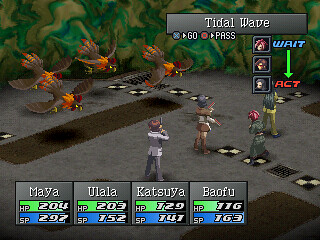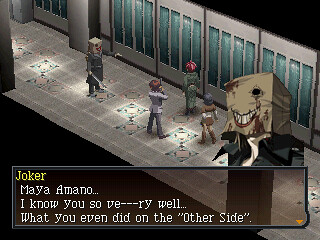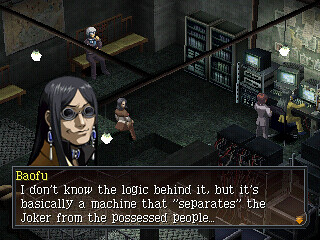
If you’re a die-hard Persona fan, there’s a good chance you have every game in the series—Persona, Persona 2: Innocent Sin, Persona 3 Portable, and the recent Persona 4 Golden—playable on PS Vita… except one. Persona 2 was split into two games — Innocent Sin and Eternal Punishment — the former of which came out on PSP in 2011 and the latter having had no American release.
There’s good news and bad news about that. The bad news is that unusual circumstances have prevented us from localizing Eternal Punishment PSP the way we’d have liked to, but the good news is that you can still find out how the story of Tatsuya Suou, Maya Amano, and the Joker curse ends! Unlike Innocent Sin, Persona 2: Eternal Punishment was localized once before on PlayStation in 2000, and it’s that version of the game that we’re bringing to PSN as a PSOne classic now.
Since Persona 2: Eternal Punishment on PSP was a port of the original, the general graphics and gameplay in this PSOne Classics release are the same as you would have gotten. You’ll still control a party of oddballs brought together by disturbing goings-on in Sumaru City: teen-focused magazine reporter Maya Amano, her unlucky-in-love boxer friend Ulala Serizawa, the upright police detective Katsuya Suou, and a shady Taiwanese fixer known as “Baofu.” Together, the four of them must hunt down the cause of the Joker Curse and unravel the mystery of a strange boy whom Maya could swear she’s seen somewhere before.
Fortunately for them, they have the power of Persona on their side. As in Innocent Sin, you have the option to fight the demons you meet or negotiate with them to earn items, assistance, or their Arcana cards in order to fuse new Personas. Spreading specific rumors through the city can also cause them to come true, which has all sorts of effects on the game.
The one thing that might throw players who got their start on the PSP or Vita is that a few of the names might seem unfamiliar. The original Eternal Punishment was sort of a halfway point in that era’s approach to localization: by that time, we were making a move toward the more faithful translations we’re known for today, but we were also mindful of the established naming conventions American players would be familiar with from “Revelations: Persona.” To help smooth things over for you, here’s a list of mental replacements to make as you go through the PSOne Classics release of Eternal Punishment:
Saeko Smith: You’d know her better as Ms. Saeko, formerly a homeroom teacher at St. Hermelin High and later on a warm, caring educator at Seven Sisters High.
Principal Harding: Principal Hannya, another veteran of St. Hermelin. In Innocent Sin, he was the hated principal of Seven Sisters who used the Joker’s power to make the students love him, even if none of them understood why.
Tammy: Tamaki, who’s actually a nod to the original Shin Megami Tensei series: she was the heroine of SMT If…, and became a devil summoner to rid Karukozaka High of evil. Now, she works for fellow devil summoner Chief Todoroki at the Kuzunoha Detective Agency.Tad: Tadashi, son of the owner of the Satomi Tadashi drugstore chain.
Mary: Maki Sonomura, the troubled heroine of Persona PSP, is now grown up and running Hiiragi Psychotherapy to help ease the minds of others who are psychologically tormented.
Sky Museum: Known as the Aerospace Museum in Innocent Sin PSP.
Ellen: Elly Kirishima in Persona PSP. She’s one of two guest stars from the original game who can briefly join your party in Eternal Punishment. The unnamed “Boy with Earring” who shows up in her route was the protagonist of that game.
Nate: Kei Nanjo, the other possible guest party member from Persona PSP. He’s the heir to the Nanjo Group megacorporation, which Persona fans with a sharp memory might know as having ties to Mitsuru Kirijo’s own business empire in Persona 3.
Yuki: Yukino Mayuzumi, another character you might know from Persona and Innocent Sin PSP. Once the leader of a girl gang at St. Hermelin, she grew up to be a professional photographer who works alongside Maya at Coolest.
Chris: Reiji Kido, sort of a hidden character in Persona PSP, will make a brief appearance in Elly’s path in Eternal Punishment.
Brad: Hidehiko “Brown” Uesugi’s routine is just as obnoxious as it was in Persona PSP, but now he’s famous for doing it on TV.
Guido: More properly known as Takahisa Kandori in Persona PSP, where he was the mastermind behind the dimensional warp that drew in the city of Mikage-cho. Though he died in the events of Persona PSP, Kandori casts a long shadow, and his influence will be felt in Sumaru City during the course of Eternal Punishment’s story.
Masquerade: Localized in Innocent Sin PSP as the “Masked Circle,” this was an innocuous child’s game that was twisted into something more sinister many years later.
Araya Shrine: Corrected to the Alaya Shrine in both earlier PSP games. “Alaya” is a Buddhist term for the uninfluenced stream of thought before it is transformed by self-knowledge and reflection.
But even if that seems like a lot to keep in your head, Persona 2: Eternal Punishment is still an accessible capstone to the story, which provides enough explanation of the callbacks and references that even newcomers can appreciate its twisting, spiraling plot that leads up to a confrontation with the grand shadow of humanity. And hey, if there’s one silver lining to this “consolation prize” version, it’s that now it’ll only run you $9.99 to get the rest of the story!















Comments are closed.
72 Comments
Loading More Comments